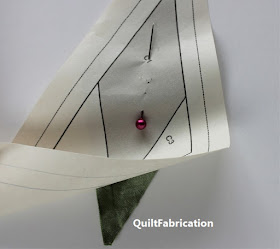These tutorials are quite long and picture heavy, so I decided to divide them up to better explain the three paper piecing techniques:
foundation paper piecing
freezer paper template piecing
freezer paper foundation piecing
The first two techniques are nicely explained in the Handy Pocket Guide to Paper Piecing by Tacha Bruecher (affiliate link), which is my April 2020 Book of the Month choice.
I'll go over my experience with both, and add in freezer paper foundation piecing which is not covered in the booklet. For today, the focus is on foundation paper piecing, the more traditional way to paper piece.
Here's a hint before starting any paper piecing project: add tick marks on the seam lines of the paper piecing pattern, as shown in red below. These marks make joining templates and units much easier to match up.
Foundation Paper Piecing
For this technique, a thin, lightweight paper is used, such as Carol Doak's Foundation Paper (affiliate link),
which is easy to sew through and tear out, though a shortened stitch length is required.
Pieces of fabric can be cut using templates, making sure of enough coverage of the area, including seams,
OR the fabric can be large pieces that are trimmed. I use a stiff card to fold back on the seam line,
then cut the seam allowance with an Add-a-Quarter ruler (affiliate link).
Either way, the first piece is pinned in place, and the next piece placed to line up at the seam edge.
I'm using a template cut piece here, but recommend a larger piece of fabric just to make sure there is enough coverage. Plus a larger piece helps with placing angled pieces.
Before stitching, verify placement and coverage by flipping the second piece over into position and holding it up to the light to check the coverage through the paper.
With foundation paper piecing, all of the stitching is done through the paper. Use a short stitch length, 1.5-2.0, and start and end the stitching just outside the seam allowance.
Press the seam, and pin the second piece, if necessary, before adding the next piece. When the unit is finished, trim the unit/block on the 1/4" seam allowance lines.
When it comes time to assemble units into a block, match up the tick marks made at the beginning, keeping the pins straight up and down. Pin through all layers perpendicular to the seam allowance to prevent shifting.
Take 5-7 basting stitches (over 5.0 in length) at crucial matching areas, checking for accuracy. It's a lot easier to rip out basting stitches than one long line of short stitches!
When all is good, stitch the seam through the papers.
Once the block is assembled, trim it to the proper size, and gently remove the paper, trying not to loosen the stitches.
And ta-da, a foundation paper pieced block is finished!
Foundation paper piecing pros and cons:
pro
- accurate
- easy to do
cons
- tedious paper removal
- no control over seam pressing direction
- patterns printed in reverse which may cause fabric size/placement confusion
Ultimately, it's a choice as to whether this is the paper piecing technique to use. For some projects, it's the best choice, for others, maybe not. Hopefully, this tutorial will a least give the confidence to try it.
There's still more to come:
Freezer Paper Template Piecing
Freezer Paper Foundation Piecing
Happy Quilting!
My Favorite Patterns




















Thanks, Susan. This is great information and you really explain each technique well. I am going to link this post with my guild's tips and techniques page.
ReplyDeleteSuper tute! Thx!
ReplyDeleteI have been looking at this post for days, wishing for some chocolate covered strawberries. Great tutorial!
ReplyDeleteHi Susan! Great idea about adding the tick marks to help line up the pieces later. I am looking forward to hearing your report and tutorial on the next two subjects. Thanks for linking up today! ~smile~ Roseanne
ReplyDeleteNice instructions. I like the tick marks. Love it when I learn something new! Thanks
ReplyDeleteThis comment has been removed by a blog administrator.
ReplyDelete